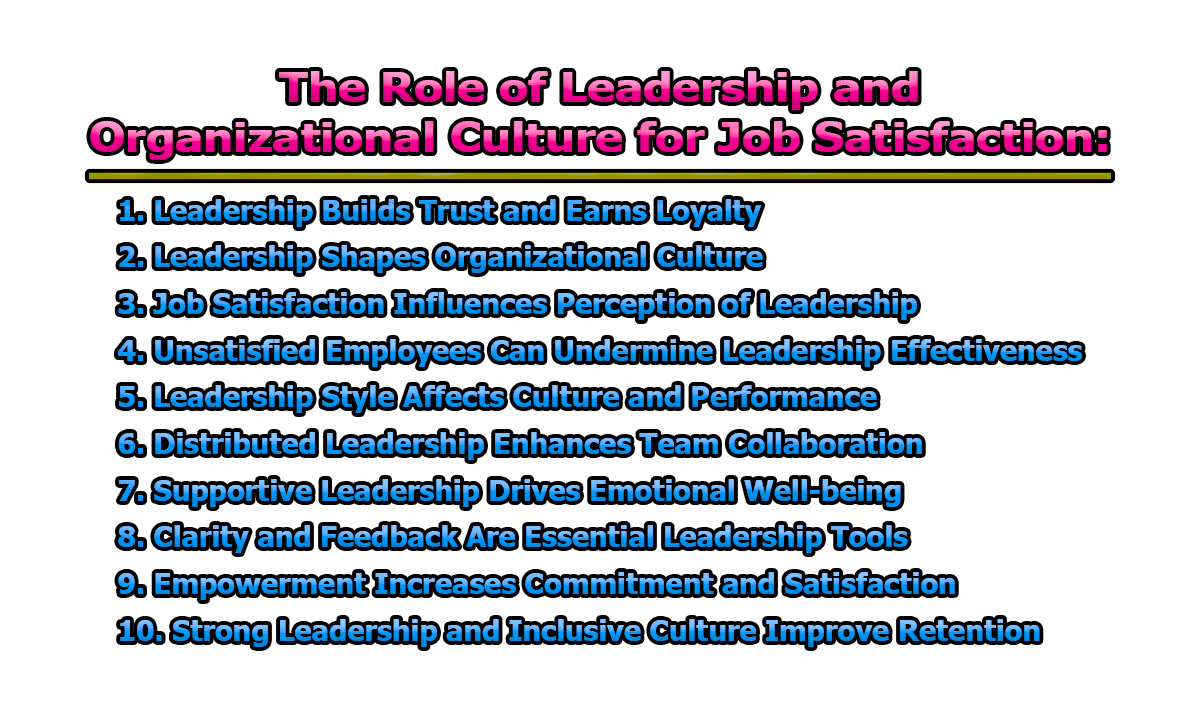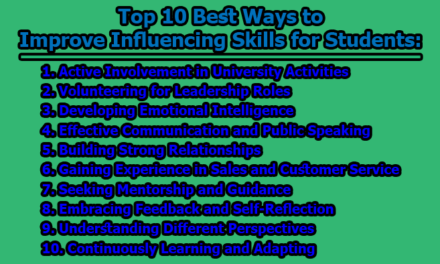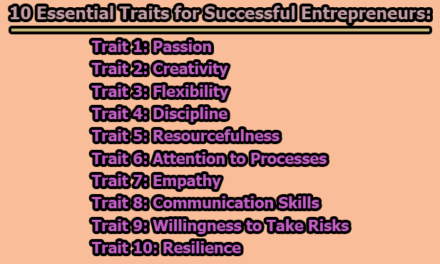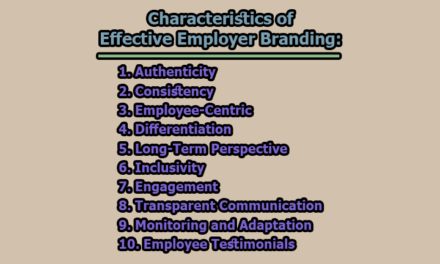The Role of Leadership and Organizational Culture for Job Satisfaction:
In today’s rapidly evolving work environment, leadership and organizational culture play a pivotal role in shaping employee experiences, performance, and long-term organizational success. As traditional models of loyalty and job security shift, employees increasingly seek workplaces that offer trust, respect, empowerment, and meaningful engagement. Leadership is not just about directing teams—it is about influencing culture, inspiring commitment, and creating an environment where individuals can thrive. In the rest of this article, we will explore the role of leadership and organizational culture for job satisfaction.
1. Leadership Builds Trust and Earns Loyalty: In the contemporary workplace, employee loyalty is no longer guaranteed through job security or tenure. Instead, trust has become the foundational element of loyalty, and it must be actively earned by organizational leaders. Employees today seek workplaces where their voices are heard, their efforts are recognized, and their well-being is prioritized. Leaders who practice transparency, fairness, empathy, and consistency create an atmosphere of psychological safety and trust, which in turn enhances employee commitment and engagement.
This shift is best captured by the well-known saying, “People don’t leave organizations; they leave bad managers.” The implication here is that the quality of leadership — more than salary or benefits — determines whether employees stay or leave. Trust-based relationships with supervisors often influence job satisfaction and the desire to contribute to long-term organizational goals.
Trust in leadership correlates with a reduction in workplace conflict, stronger team collaboration, and increased organizational citizenship behaviors. Leaders who embody ethical and emotionally intelligent behavior help to build these trust-based cultures.
2. Leadership Shapes Organizational Culture: Organizational culture refers to the shared values, norms, beliefs, and practices that guide behavior within an organization. Leadership plays a pivotal role in crafting, maintaining, and evolving this culture. Through daily interactions, decisions, communication styles, and response to challenges, leaders transmit values and set the tone for what is acceptable and rewarded within the workplace.
Culture is not formed in isolation; it emerges through repeated patterns of behavior that are often modeled by those in positions of authority. Leaders function as cultural architects, whether intentionally or not. For instance, a leader who emphasizes collaboration and open communication is likely to cultivate a culture of teamwork, whereas a leader who prioritizes control and top-down decision-making might instill a culture of compliance and caution.
This dynamic underscores the importance of self-awareness in leadership. When leaders are intentional about aligning their behaviors with the desired cultural attributes — such as innovation, inclusion, or agility — they can drive transformation and long-term organizational success.
3. Job Satisfaction Influences Perception of Leadership: While leadership affects job satisfaction, the reverse is also true: employees’ levels of satisfaction can influence how they perceive and interpret their leaders’ behaviors. A study by Kauppila (2025) demonstrates that job satisfaction acts as a psychological filter. Employees who are satisfied with their work tend to view their leaders more favorably, often interpreting neutral or ambiguous actions as positive. Conversely, dissatisfied employees may project their frustrations onto leadership, even if the leader is performing adequately.
This two-way relationship has significant implications for leadership effectiveness. It suggests that even skilled leaders may struggle to gain credibility and engagement in environments with low employee morale. Conversely, in a positive work environment, leadership actions are more likely to be amplified and well-received.
Understanding this dynamic is critical for leaders aiming to foster healthy workplaces. Improving job satisfaction—through fair workload distribution, career development, work-life balance, and recognition—can positively influence how leadership is perceived, creating a reinforcing cycle of trust and engagement.
4. Unsatisfied Employees Can Undermine Leadership Effectiveness: Leadership is most effective when employees are engaged, motivated, and psychologically well. However, when employees are unsatisfied—due to unclear expectations, lack of growth, or a toxic culture—their frustration often affects their leaders. Unmet employee needs can lead to withdrawal behaviors, reduced productivity, and emotional exhaustion, which in turn place increased pressure on leaders. Burned-out employees are less likely to trust leadership and may interpret even well-meaning initiatives with skepticism.
Moreover, the stress of managing disengaged or unhappy teams can contribute to leadership burnout, creating a vicious cycle. Leaders may become reactive rather than proactive, which further deteriorates morale. This reciprocal burnout dynamic between leaders and followers indicates that job satisfaction is not just an HR concern—it is central to leadership resilience and effectiveness.
To prevent this, leaders must be attuned to the emotional climate of their teams and adopt proactive strategies such as regular check-ins, inclusive decision-making, and recognizing employee contributions. A workplace that fosters well-being supports both employee satisfaction and sustainable leadership.
5. Leadership Style Affects Culture and Performance: Different leadership styles influence organizational outcomes and employee experiences in varied ways. For instance, self-actualized leaders—those who are emotionally intelligent, growth-oriented, and focused on individual strengths—create work environments where employees feel seen and valued. These leaders seek to match employees’ tasks with their skills and aspirations, enhancing a sense of meaning and personal development.
In contrast, authoritarian or overly transactional leadership may achieve short-term compliance but often suppress creativity, reduce engagement, and lead to high turnover. Al-Husseini et al. (2021) found that transformational and participative leadership styles positively impact job satisfaction, especially when employees feel empowered in their roles.
Ultimately, the chosen leadership style becomes a mechanism through which organizational culture is enacted. A leadership approach that aligns with values such as inclusion, integrity, and growth creates a culture where those same values flourish.
6. Distributed Leadership Enhances Team Collaboration: Distributed leadership—a model in which leadership responsibilities are shared among various individuals rather than centralized in a single authority figure—has emerged as a powerful approach in modern organizational settings. This leadership style empowers team members by involving them in planning, decision-making, and implementation, thereby increasing their sense of ownership and accountability.
García-Buades et al. (2019) argue that distributed leadership fosters a culture of collaboration and mutual respect. When employees have a voice in shaping outcomes, they are more likely to feel connected to their work and colleagues, which enhances job satisfaction and reduces conflict. It also encourages innovation, as ideas are sourced from a broader range of perspectives.
Additionally, distributed leadership aligns well with agile work environments and interdisciplinary teams, where flexibility and shared knowledge are essential. This approach not only enhances teamwork but also builds collective efficacy—employees’ shared belief in their team’s capacity to succeed.
7. Supportive Leadership Drives Emotional Well-being: A supportive leadership style is crucial in promoting the emotional well-being and psychological safety of employees. Supportive leaders take time to understand individual employee needs, respond empathetically to concerns, and provide encouragement during challenges. They also act as buffers against workplace stress by managing workloads fairly and offering flexible solutions.
According to Al-Husseini et al. (2021), employees who perceive their leaders as emotionally supportive report higher levels of satisfaction and motivation. This type of leadership fosters an inclusive and compassionate work environment, reducing turnover intention and increasing loyalty. Supportive leadership also plays a critical role in cultivating trust—an essential foundation for psychological resilience and team cohesion.
By actively listening, validating employee experiences, and showing appreciation, leaders not only improve morale but also enhance performance, creativity, and collaboration across teams.
8. Clarity and Feedback Are Essential Leadership Tools: Employees thrive in environments where expectations are clearly communicated, and feedback is timely, specific, and constructive. Leaders who clearly define roles and goals help reduce ambiguity, which is a known stressor in the workplace. In turn, this clarity enables employees to perform their duties confidently and efficiently.
Edmondson (1999) emphasized the importance of psychological safety and learning behavior, noting that effective leaders create a culture where feedback is not feared but embraced as a tool for growth. Constructive feedback allows employees to understand their strengths and areas for improvement while reinforcing a culture of continuous learning.
Leaders who regularly provide guidance and coaching build stronger developmental relationships with their team members. This not only boosts employee performance but also reinforces a culture of accountability and mutual respect.
9. Empowerment Increases Commitment and Satisfaction: Empowering leadership involves giving employees the autonomy to make decisions and actively participate in shaping their work processes. This type of leadership builds a sense of ownership, trust, and self-efficacy, which increases job satisfaction and organizational commitment.
Prentice (2022) found that when employees are involved in decision-making and are trusted with responsibility, they feel more valued and motivated to contribute to the organization’s success. Empowerment promotes innovation, encourages initiative, and fosters a deeper emotional connection between employees and their work.
Moreover, empowered employees tend to exhibit higher engagement levels, reduced absenteeism, and improved collaboration, all of which contribute to stronger organizational performance and employee retention.
10. Strong Leadership and Inclusive Culture Improve Retention: Organizations that prioritize both strong leadership and an inclusive, values-driven culture are significantly more likely to retain talented employees. Leaders who are committed to equity, diversity, and respect create environments where all employees feel seen, heard, and appreciated.
When leadership and culture are aligned—particularly around principles like transparency, fairness, innovation, and collaboration—employees are more likely to experience a sense of belonging. This connection contributes to higher retention rates, increased engagement, and improved organizational performance.
Such workplaces also become more adaptive and resilient in times of change, as employees trust that leadership will navigate challenges ethically and inclusively. The alignment of leadership practices and cultural values is thus a key driver of long-term organizational sustainability.
In conclusion, leadership and organizational culture are deeply interconnected forces that shape the heart of any organization. Effective leadership fosters trust, clarity, empowerment, and emotional well-being, while a strong, inclusive culture amplifies these efforts by reinforcing shared values and norms. Together, they form the foundation of a workplace where employees feel motivated, respected, and committed. Organizations that recognize and invest in this dynamic relationship are better positioned to retain talent, navigate challenges, and achieve sustainable success.
Frequently Asked Questions (FAQs):
Why is leadership important in shaping organizational culture?
Leadership sets the tone for workplace behavior, communication, and values. Leaders influence what is accepted and rewarded in an organization, thereby shaping the overall culture and employee experience.
How does organizational culture impact employee job satisfaction?
A positive culture built on trust, inclusion, and shared values leads to higher job satisfaction. Employees are more likely to be engaged, loyal, and productive in cultures where they feel respected and supported.
What are some leadership styles that positively affect culture and satisfaction?
Transformational, supportive, and distributed leadership styles are particularly effective. These styles promote empowerment, collaboration, emotional support, and personal development.
What is distributed leadership, and why is it effective?
Distributed leadership involves sharing leadership responsibilities across a team rather than concentrating them in one person. It enhances collaboration, builds ownership, and increases team engagement and effectiveness.
How does job satisfaction influence the perception of leadership?
Employees with higher job satisfaction tend to view their leaders more favorably. Conversely, dissatisfaction can distort how leadership behavior is interpreted, sometimes unfairly blaming leaders for systemic issues.
What role does feedback play in leadership and culture?
Regular, constructive feedback helps clarify expectations, supports continuous improvement, and builds trust. It is a critical tool for leaders in developing a high-performance and learning-oriented culture.
How does leadership affect employee retention?
Supportive and empowering leaders contribute to a positive work environment where employees feel valued. This significantly reduces turnover and enhances long-term organizational commitment.
Can a leader change an existing organizational culture?
Yes, but it requires intentional effort, consistency, and alignment of actions with core values. Change is often gradual and involves engaging employees at all levels in shaping new norms and behaviors.
What is the relationship between empowerment and job satisfaction?
When employees are empowered to make decisions and contribute meaningfully, they feel trusted and respected. This increases their sense of purpose, satisfaction, and loyalty to the organization.
What happens when leadership and culture are misaligned?
Misalignment can lead to confusion, mistrust, and disengagement. Employees may feel unsupported or conflicted about expectations, ultimately reducing productivity and increasing turnover.
References:
- Al-Husseini, S., El Beltagi, I., & Moizer, J. (2021). Transformational Leadership and Innovation: The Mediating Role of Knowledge Sharing amongst Higher Education Faculty. International Journal of Leadership in Education, 24, 670-693. https://doi.org/10.1080/13603124.2019.1588381
- Al-Owaidi, A. R., Al-Nuaimi, S. S., & Nteboheng, S. (2023). Leadership style and its relationship to job satisfaction for employees. Open Journal of Business and Management, 11(6), 2831–2850. https://doi.org/10.4236/ojbm.2023.116156
- Edmondson, A. C. (1999). Psychological safety and learning behavior in work teams. Administrative Science Quarterly, 44(2), 350–383. https://doi.org/10.2307/2666999
- García-Buades, M., Peiró, J., Montañez-Juan, M., Kozusznik, M., & Ortiz-Bonnin, S. (2019). Happy-productive teams and work units: A systematic review of the ‘happy-productive worker thesis’. International Journal of Environmental Research and Public Health, 17(1). https://doi.org/10.3390/ijerph17010069
- Kauppila, O. P. (2025). Revisiting the relationships between leadership and job satisfaction. European Management Review, 22(1), 256–270. https://doi.org/10.1111/emre.12637
- Prentice, S. B. (2022). Job satisfaction or employee engagement: Regardless of which comes first, supportive leadership improves them both. Advances in Developing Human Resources, 24(4), 275–285. https://doi.org/10.1177/15234223221112504
- Schein, E. H. (2010). Organizational Culture and Leadership (4th ed.). San Francisco, CA: Jossey-Bass.

Library Lecturer at Nurul Amin Degree College










